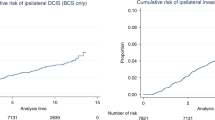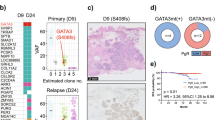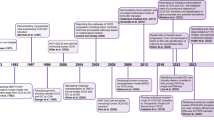Abstract
We have investigated primary ductal carcinomas in situ (DCIS) of the breast and their local recurrences after breast-conserving therapy (BCT) for histological characteristics and marker expression. Patients who were randomized in the EORTC trial 10853 (wide local excision versus excision plus radiotherapy) and who developed a local recurrence were identified. Histology was reviewed for 116 cases; oestrogen and progesterone receptor status, and HER2/neu and p53 overexpression were assessed for 71 cases. Comparing the primary DCIS and the invasive or non-invasive recurrence, concordant histology was found in 62%, and identical marker expression in 63%. Although 11% of the recurrences developed at a distance from the primary DCIS, nearly all these showed the same histological and immunohistochemical profile. 5 patients developed well-differentiated DCIS or grade I invasive carcinoma after poorly differentiated DCIS. Although these recurrences occurred in the same quadrant as the primary DCIS, they may be considered as second primary tumours. Only 4 patients developed poorly differentiated DCIS or grade III invasive carcinoma after well differentiated DCIS. We conclude that in most cases the primary DCIS and its local recurrence are related histologically or by marker expression, suggesting that local recurrence usually reflects outgrowth of residual DCIS; progression of well differentiated DCIS towards poorly differentiated DCIS or grade III invasive carcinoma is a non-frequent event. © 2001 Cancer Research Campaign
Similar content being viewed by others
Article PDF
Change history
16 November 2011
This paper was modified 12 months after initial publication to switch to Creative Commons licence terms, as noted at publication
References
Altman DL (1997). Practical statistics for medical research, p. 406 Chapman & Hall: London
Bobrow LG, Happerfield LC, Gregory WM, Springall RD and Millis RR (1994) The classification of ductal carcinoma in situ and its association with biological markers. Semin Diagn Pathol 11: 199–207
Elston CW and Ellis IO (1991) Pathological prognostic factors in breast cancer. I. The value of histological grade in breast cancer: experience from a large study with long-term follow-up. Histopathology 19: 403–410
Ernster VL, Barclay J, Kerlikowske K, Grady D and Henderson C (1996) Incidence of and treatment for ductal carcinoma in situ of the breast. JAMA 275: 913–918
Goldstein NS and Murphy T (1996) Intraductal carcinoma associated with invasive carcinoma of the breast. A comparison of the two lesions with implications for intraductal carcinoma classification systems. Am J Clin Pathol 106: 312–318
Gupta SK, Douglas-Jones AG, Fenn N, Morgan JM and Mansel RE (1997) The clinical behavior of breast carcinoma is probably determined at the preinvasive stage (ductal carcinoma in situ). Cancer 80: 1740–1745
Holland R, Peterse JL, Millis RR, Eusebi V, Faverly D, Van de Vijver MJ and Zafrani B (1994) Ductal carcinoma in situ: a proposal for a new classification. Semin Diagn Pathol 11: 167–180
Julien JP, Bijker N, Fentiman IS, Peterse JL, Delledonne V, Rouanet P, Avril A, Sylvester R, Mignolet F, Bartelink H and Van Dongen JA (2000) Radiotherapy in breast-conserving treatment for ductal carcinoma in situ: first results of the EORTC randomised phase III trial 10853. EORTC Breast Cancer Cooperative Group and EORTC Radiotherapy Group. Lancet 355: 528–533
Lampejo OT, Barnes DM, Smith P and Millis RR (1994) Evaluation of infiltrating ductal carcinomas with a DCIS component: correlation of the histologic type of the in situ component with grade of the infiltrating component. Semin Diagn Pathol 11: 215–222
Leal CB, Schmitt FC, Bento MJ, Maia NC and Lopes CS (1995) Ductal carcinoma in situ of the breast. Histologic categorization and its relationship to ploidy and immunohistochemical expression of hormone receptors, p53, and c-erbB-2 protein. Cancer 75: 2123–2131
Lininger RA, Fujii H, Man YG, Gabrielson E and Tavassoli FA (1998) Comparison of loss of heterozygosity in primary and recurrent ductal carcinoma in situ of the breast. Mod Pathol 11: 1151–1159
Mack L, Kerkvliet N, Doig G and O’Malley FP (1997) Relationship of a new histological categorization of ductal carcinoma in situ of the breast with size and the immunohistochemical expression of p53, c-erb B2, bcl-2, and ki-67. Hum Pathol 28: 974–979
Millis RR, Barnes DM, Lampejo OT, Egan MK and Smith P (1998) Tumour grade does not change between primary and recurrent mammary carcinoma. Eur J Cancer 34: 548–553
Perin T, Canzonieri V, Massarut S, Bidoli E, Rossi C, Roncadin M and Carbone A (1996) Immunohistochemical evaluation of multiple biological markers in ductal carcinoma in situ of the breast. Eur J Cancer 32A: 1148–1155
Sloane JP, Amendoeira I, Apostolikas N, Bellocq JP, Bianchi S, Boecker W, Bussolati G, Coleman D, Connolly CE, Dervan P, Eusebi V, De Miguel C, Drijkoningen M, Elston CW, Faverley D, Gad A, Jacquemier J, Lacerda M, Martinez-Penuela J, Munt C, Peterse JL, Rank F, Sylvan M, Tsakraklides V and Zafrani B (1998) Consistency achieved by 23 European pathologists in categorizing ductal carcinoma in situ of the breast using five classifications. European Commission Working Group on Breast Screening Pathology. Hum Pathol 29: 1056–1062
Van de Vijver MJ, Peterse JL, Mooi WJ, Wisman P, Lomans J, Dalesio O and Nusse R (1988) Neu-protein overexpression in breast cancer. Association with comedo-type ductal carcinoma in situ and limited prognostic value in stage II breast cancer. N Engl J Med 319: 1239–1245
Waldman FM, DeVries S, Chew KL, Moore DH 2nd, Kerlikowske K and Ljung BM (2000) Chromosomal alterations in ductal carcinomas in situ and their in situ Recurrences. J Natl Cancer Inst 92: 313–320
World Health Organisation (1981). Histologic typing of breast tumors, 2nd ed, WHO: Geneva
Zafrani B, Leroyer A, Fourquet A, Laurent M, Trophilme D, Validire P and Sastre-Garau X (1994) Mammographically-detected ductal in situ carcinoma of the breast analyzed with a new classification. A study of 127 cases: correlation with estrogen and progesterone receptors, p53 and c-erbB-2 proteins, and proliferative activity. Semin Diagn Pathol 11: 208–214
Author information
Authors and Affiliations
Corresponding author
Rights and permissions
From twelve months after its original publication, this work is licensed under the Creative Commons Attribution-NonCommercial-Share Alike 3.0 Unported License. To view a copy of this license, visit http://creativecommons.org/licenses/by-nc-sa/3.0/
About this article
Cite this article
Bijker, N., Peterse, J., Duchateau, L. et al. Histological type and marker expression of the primary tumour compared with its local recurrence after breast-conserving therapy for ductal carcinoma in situ. Br J Cancer 84, 539–544 (2001). https://doi.org/10.1054/bjoc.2000.1618
Received:
Revised:
Accepted:
Published:
Issue date:
DOI: https://doi.org/10.1054/bjoc.2000.1618
Keywords
This article is cited by
-
Is conservative management of ductal carcinoma in situ risky?
npj Breast Cancer (2022)
-
Characteristics of second breast events among women treated with breast-conserving surgery for DCIS in the community
Breast Cancer Research and Treatment (2016)
-
Co-expression of p16 and p53 characterizes aggressive subtypes of ductal intraepithelial neoplasia
Virchows Archiv (2016)
-
Human epidermal growth factor receptor 2-positive microinvasive breast carcinoma with a highly aggressive course: a case report
BMC Research Notes (2014)
-
Is DCIS Breast Cancer, and How Do I Treat it?
Current Treatment Options in Oncology (2013)



